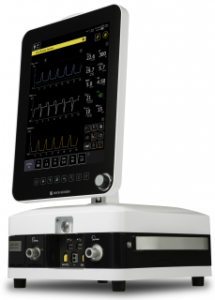How does artificial ventilation work?
What are the main uses of a breathing ventilator?
What are the main ventilation modes?
Choosing the right ventilator
A ventilator or respirator is a medical device used to supplement a patient’s respiratory function. This is referred to as mechanical or artificial ventilation. They are generally used in cases of respiratory arrest or distress, i.e. when the patient’s breathing (natural or spontaneous ventilation) is no longer sufficient to ensure an adequate supply of oxygen. A ventilator is also intended to protect the airways and lungs until they regain their function.
How does artificial ventilation work?
aXcent ventilator
There are two main types of artificial ventilation: invasive and non-invasive. The purpose of both is to support the patient’s natural breathing when it is insufficient.
The differences between invasive and non-invasive ventilation are as follows:
- Invasive ventilation requires intubation of the patient. Air is delivered through a tube that is inserted into the trachea. This may require a tracheotomy. The process of invasive ventilation is more risky than that of non-invasive ventilation.
- With non-invasive ventilation(NIV) the patient is not intubated. The air is delivered through a mask that is placed over the patient’s nose and/or mouth. This process is the least dangerous.
In both cases, the ventilator that is connected to the tube or mask will provide all phases of the patient’s respiratory cycle, namely:
- Inspiratory trigger: the mechanism by which the ventilator will recognize the start of inspiration in the patient and thus trigger the respiratory cycle
- Inspiration
- Inspiratory pause
- End of inspiration
- Expiration
What are the main uses of a breathing ventilator?
WEINMANN emergency ventilator
There are several fields that can require patient ventilation such as emergency care, intensive care and the operating room.
- Emergency care requires ventilators that are easy to trasport, especially in cases where the patient needs to be ventilated directly in the ambulance before being taken to hospital.
- Intensive care and resuscitation: for this type of care, ventilators are generally used for long-term treatment and have several ventilation modes.
- Operating room and anesthesia: in this specific case, ventilators must be designed for use with anesthetic gases. They are usually integrated into the anesthesia stations.
What are the main ventilation modes?
Nihon Kohden resuscitation ventilator
There are many different ventilation modes. They are usually divided into two broad categories: controlled ventilation modes and assisted ventilation modes.
- Controlled (or total) ventilatory modes: these modes are generally used for patients without spontaneous respiration (in respiratory arrest). All ventilation is controlled by health professionals. Patients are either sedated or administered with curare throughout the ventilation period. Controlled ventilation modes include:
- Volume-controlled (VC) or volumetric ventilation: this mode determines the volume of air insufflated to the patient during the inspiratory phase. This ensures that the patient receives a fixed tidal volume (Vt). Expiration is triggered when the Vt has been administered. This mode is not suitable for non-invasive ventilation as it does not compensate for leaks.
- Pressure-controlled ventilation (PCV) or barometric ventilation: this mode determines the pressure of the air to be insufflated into the lungs during the inspiratory phase. Spirometry and capnography must be monitored.
- Assisted (or partial) ventilatory modes: these modes are used in patients with limited spontaneous ventilation (in respiratory distress) or who are undergoing respiratory withdrawal. Spontaneous cycles with pressure support are delivered to the patient. There is also synchronized intermittent mandatory ventilation (SIMV) in which a patient’s effort to breathe can trigger a spontanous breath.
What are the potential risks associated with using a ventilator?
Dräger resuscitation ventilator
The main risks of a ventilator are related to setting the ventilation parameters. Incorrect tidal volume adjustment or patient-ventilator asynchronies can occur.
- Incorrect tidal volume (Vt) setting: with volume-controlled ventilation, too high a Vt can lead to pulmonary volotrauma, while too low a Vt can cause alveolar derecruitment leading to hypoxemia.
- Patient-ventilator asynchronies: Patient-ventilator asynchronies consist of a time lag between the patient’s inspiratory time and the ventilator’s insufflation time. Ineffective exertion: when an effort is generated by the patient but not detected by the ventilator. This is the most frequently detected asynchrony. Optimization of the ventilation parameters can reduce this type of asynchrony. Asynchronies are common in clinical practice. It should be noted, however, that the latest generation of ventilators with monitoring screens make it possible to efficiently and quickly detect the most common asynchronies.

